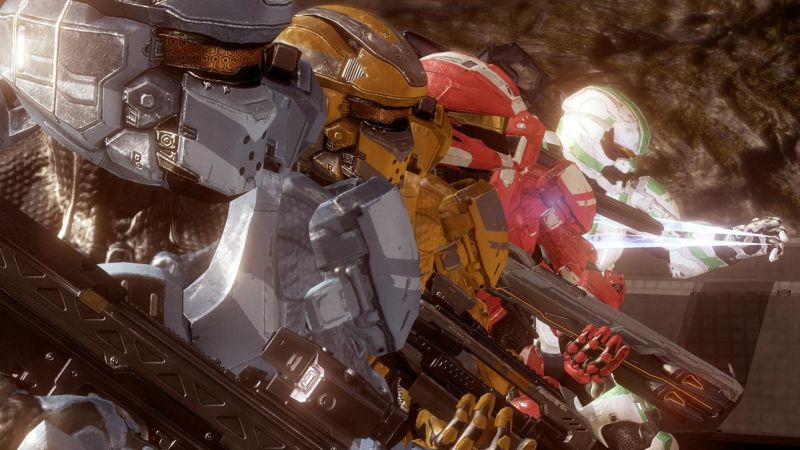 Courtesy of blogs-images.forbes.com
Courtesy of blogs-images.forbes.com
By Aaron Sanders, Diversions Editor
16 November 2012
Xbox owners rejoice for Master Chief has returned and is better than ever. After a slew of spin-off games, Halo 4 sees the return of gaming icon Master Chief as he faces a new threat to humanity. 343 Studios, the successor to Bungie, dons the mantle of the franchise and delivers a cathartic campaign and a surprisingly smooth multiplayer experience.
Halo 4 takes place three years after the third game, and apparently in those three years a lot has changed in the Halo universe. The war with the Covenant is over and humanity is now the dominant species in the celestial system. The United Nations Space Command (UNSC) has begun producing Spartans again in order to help find the remaining Halo rings and establish human research facilities. And during all of this, the Chief has been in cryo-sleep in the destroyed ship Forward Unto Dawn and his personal AI, Cortana, has entered rampancy, a state of deterioration.
When Cortana, keeping in tune with Master Chief’s final words in Halo 3, finally “needs him,” she awakens him from his eternal slumber to find the ship in the orbit of a Forerunner planet called Requiem. (For those unfamiliar with the Forerunners, they are the species responsible for creating the Halos.) Once on Requiem, Master Chief comes across the new major adversaries of the game: the Prometheans (robotic, organic hybrid creatures). This also ushers in the introduction of a plethora of new toys: the Lightrifle (a combination of the human Battle Rifle and Designated Marksman Rifle), the Suppressor (a counterpart to the human Assault Rifle), the Boltshot (a pistol with a shotgun capability), the Binary Rifle (a devastating sniper rifle), the Scattershot (essentially a shotgun) and, most notably, the Incinerator (a rocket launcher/flamethrower/shotgun hybrid weapon).
The Prometheans come in three forms, with some deviations within those classes: crawlers, watchers and knights. While the Promethean Knights are undoubtedly the most dangerous enemy, the watchers and crawlers —quite easy to deal with in small quantities—can still easily overwhelm Master Chief.
Back to the story; Master Chief and Cortana reunite with a human vessel and embark on a journey through Requiem to stop a rogue Forerunner from annihilating humanity and remedy Cortana’s rampancy.
 Courtesy of timenerdworld.files.wordpress.com
Courtesy of timenerdworld.files.wordpress.com
Halo 4’s campaign is the most human of all the games thus far. Master Chief, known to many as the laconic hero, has infinitely more lines in this installment and actually shows empathy towards his dying companion. In a way, Halo 4 is one part action adventure and one part tragic romance, as the intimate relationship between Chief and Cortana is inspected and dissected. The player shares Master Chief’s anxiety for Cortana’s well being as she begins to tear at the seams. Jen Taylor’s heart-wrenching performance as Cortana is sure to garner many awards in the coming months.
As a replacement to Firefight, Halo 4 introduces a new game mode called Spec-Ops (a.k.a. Halo: Infinity), which is a mission-based mode (sort of like Call of Duty’s Special Ops mode) that has its own story in the context of the campaign. The player controls his or her own customized Spartan warrior as he or she runs through a variety of missions throughout Requiem: assault, recon, rescue, etc. Spec-Ops is released in sets of five missions with an extended short movie to provide context for said missions. Every week, 343 will release a new episode of the miniseries with a new set of five missions and movie clip. From a gameplay standpoint, Spec-Ops is a blast. While the missions are not painstakingly difficult, they can get quite sticky, especially when the game spawns thirty enemies at one time. The only complaint about the new game mode is that you visit the same maps that are in the campaign. It would be cool to play unseen locations in later episodes.
Anyone who owns an Xbox knows that Halo is the king when it comes to quality multiplayer, and Halo 4 does not disappoint. Multiplayer is very similar to that of Halo: Reach, but it builds on it. Halo 4’s multiplayer employs a create-a-class system for the first time, along with perks and armor customizations. Each player can now select a desired primary weapon (Battle Rifle, DMR, Assault Rifle, Carbine, Storm Rifle, Lightrifle or Suppressor), a secondary weapon (Magnum, Plasma Pistol or Boltshot), a grenade type (Frag, Plasma or Pulse), an armor ability and perk. Variety is clearly no issue; however, most will likely cling to the deadly accurate DMR (which you can hip-fire headshots from across the biggest maps) or the Battle Rifle (which is essentially a weaker but faster version of the DMR), which can become frustrating for players experimenting with the other weapons.
In addition to the over-usage of the DMR and Battle Rifle, the multiplayer employs an auto-aim feature, which has personally driven me into a “nerd rage” on more than one occasion. When employing auto-aim—if you’re shooting anywhere near someone’s head—the game counts the bullet as a headshot, which means a lot of sudden deaths and a lot of nerd rages. Hopefully in the coming months, 343 can rectify the issue. Other than that, the multiplayer is great.
Halo 4 is, as of now, one of the top three games of 2012. Along with Max Payne 3 and Mass Effect 3, Halo 4 raises the bar for first-person shooters. From the epic yet intimate campaign to the addictive multiplayer and Spec-Ops modes, the new Halo is an absolute must-buy for gamers of all varieties.
Until the release of next year’s Bioshock Infinite and Gears of War Judgment, Halo 4 will see its cozy home in my disc tray.
10/10

